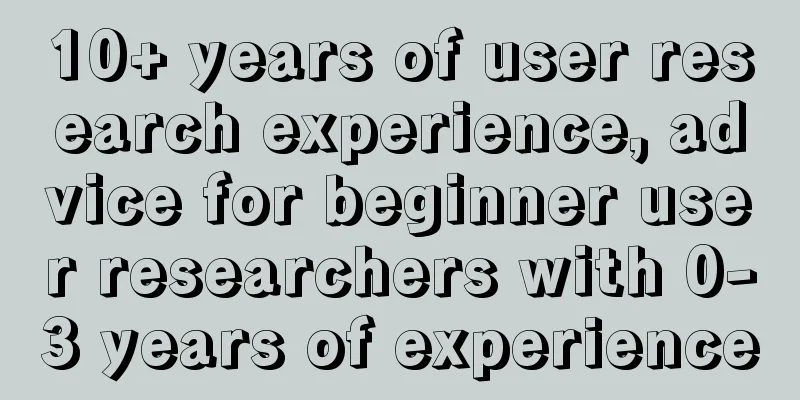10+ years of user research experience, advice for beginner user researchers with 0-3 years of experience

If you are a new user researcher who has been in the industry for less than 3 years and want to work in this field for a long time and continue to improve in the field of user research, then you must read this article. I will give you some practical suggestions based on my own professional experience and experience in guiding students. 1. Laying a solid professional foundation is more important than anything elseThe biggest fear when doing research is that the professional foundation is not solid. If the professional foundation is not solid, the more you move up, the less confident you will be. In the field of user research, you will always be a half-baked person and will never go far in your career. And speaking from my experience as a person who has been through it, it is better to lay a solid foundation right from the start than to keep patching things up later. This is actually the most effective way to achieve career growth. What professional foundations should be laid? The core of user research is quantitative research, which involves statistics and data analysis, so you must master the basic knowledge of statistics and data analysis, such as descriptive statistics (central tendency, discrete trend, distribution), inferential statistics, hypothesis testing, regression, clustering, etc. In addition, you also need to master the use of tools related to data processing and analysis. It is best to systematically study books such as "SPSS Practice and Statistical Thinking" that combine theory and practice, and be proficient and proficient in everything from downloading questionnaire data to exporting, cleaning, coding, weighting, table generation, and analysis. To do user research, you need to master research methods. Whether it is quantitative research methods or qualitative research methods, you need to not only be able to practice but also master the theory. Here you'd better master the basic knowledge of sociological research methods, because user research methods are derived from social science research methods. I suggest that you systematically study books and courses related to sociology. You can find "Social Research Methods" (Feng Xiaotian, China Renmin University Press), "Social Research Methods Textbook" (Yuan Fang, Peking University Press), etc. and read them carefully. In addition, you can study psychology, which will help you gain insights into users; and continue to learn business knowledge and thinking, which will help you implement user research. How to efficiently lay a professional foundation? From the perspective of career path selection, large first-party factories and leading second-party market research companies are the best platforms for you to lay the foundation. The former has a systematic new employee training system, and the latter has abundant practical project opportunities + mature solutions + decades or even hundreds of years of knowledge accumulation. If you don't have this condition, what you should consider most is to hire foreign aid as soon as possible and find a master to guide you to lay the foundation. It is ten times or even a hundred times better than groping there on your own. After all, the golden period of a career is only ten years, and this investment is definitely worth it. 2. Focus on three points in work: project execution, data processing and analysis, and report outputIn general, junior researchers have only one core goal in the first three years, which is to learn to be a good executor: to assist in completing projects quickly and well. To achieve this goal, junior researchers need to understand and be familiar with the project process, take on the specific work of research execution, and learn to process data and assist in report writing. Among them, the project process is relatively easy to get started and master. Basically, a newcomer will have a good grasp of the project process and details after completing a project. Research execution, data processing, and report writing involve the mastery of many research methods and tools, and are the key to learning and accumulation. Research execution. That is, the means and methods of obtaining market and user information by integrating internal and external resources. There are many research methods, which need to be flexibly selected and used according to needs. It is not easy to fully and thoroughly master a certain research method. (▲User research methods/classified by 3 dimensions) The so-called complete and thorough mastery of a research method means that one needs to have a clear understanding and personal practice of the theoretical origins, history, iterative evolution of the method, application scenarios, operational details, advantages and disadvantages, etc. of this research method. Take the most common and basic usability testing as an example. Many people who have been engaged in the industry for many years may only have a superficial understanding and only know how to operate it roughly. If you don’t have the spirit of digging deep and seeking knowledge, you may be unable to answer the questions about the details of a method asked by the business side one day, which will lead to doubts about your professionalism. For example:
… How do you measure whether you have thoroughly mastered a research method? One way is to ask yourself whether you can write the research method into training materials and share it with others, or write a case sharing article in conjunction with the project. Data processing. After the data is collected, it is necessary to clean the data, remove unqualified samples, and then analyze it through data analysis tools. This requires proficiency in Excel and SPSS software. Some company research teams even require the mastery of computer programming languages such as SQL and Python to extract big data analysis by themselves. However, with the Kanbanization of big data, the division of labor and cooperation with data analysts has become closer, so it is not a mandatory requirement. It is best to learn these practical skills through training courses or training camps. Let experienced teachers teach you step by step. Otherwise, it will take a lot of time to figure it out on your own and you may still make mistakes. Report writing. It is required to be able to present data results according to the original design, write data reports, and assist in PPT charting. It is not required to interpret and understand the data (basic ability to read and explain the pictures is required), but the details of the data must be very clear, and the corresponding data results must be quickly retrieved and presented as required. 3. Suggestions for improving your abilitiesIn terms of positions, entry-level user researchers generally include three levels: assistant user researcher (E1), user research specialist (E2), and senior/experienced user researcher (E3). Assistant user researchers and user research specialists place more emphasis on the cultivation of general abilities, the learning and mastering of professional knowledge or skills, and just need to obey orders and do a good job of execution within the team; senior/experienced user researchers begin to require the ability to apply professional knowledge and skills, to be able to produce outputs, but are not yet required to be able to lead projects. If you move up to the User Research Manager (E4) level, you will be able to take charge of your own projects and manage relationships with clients and business demanders. When reaching the research manager level, it means that there are generally no major problems at the execution level. The core goal of this stage is to transform from a project executor to a full-process project manager. The so-called full-process project manager means that the ability to cover the project process should extend from the middle execution to both ends. The front end includes "customer" demand docking, research and design, and the back end includes data interpretation and insight, and reporting implementation. Demand matching. If you treat the business side as the customer you serve, how do you deal with this customer? There are several key points: First, you need to understand the business. It is not enough to just understand, you also need to have a deeper understanding of the business. How deep is it? The answer is that the closer to the business side's cognitive level, the better, so that the communication can be on the same channel, the so-called "resonance at the same frequency"; second, when your business side raises a demand, you can use your professionalism to make your own judgment and evaluation of the business demand/problem, that is, you can take it on. Don't say that they come to you to synchronize the demand, and you say I need to think about it; third, even if it is a colleague relationship, it is necessary to maintain the "customer relationship" on a daily basis. Meeting up for a meal from time to time, and getting together on weekends can help convey the demand more smoothly. Research design. The key points here include: first, the transformation from business needs/problems to research propositions, also known as the "critical leap", which tests both the understanding of the business and the grasp of the boundaries of user research capabilities; second, obtaining the required user information through scientific and reasonable research methods. The so-called "scientific and reasonable" must consider both the feasibility of the method and the cost and efficiency, which requires a clear judgment on the importance level of the needs and the internal and external resources of the enterprise. Report output. Interpret the market and user information obtained, present it in an appropriate form (usually PPT), and be responsible for the final insight results. Different from researchers, research managers need to lead the construction of the report outline and the general direction of the conclusion. Report implementation. Reporting to the front line of business is completely different from reporting to senior business executives: reporting to the former requires attention to the comprehensiveness, details, and feasibility of the information; reporting to the latter requires more attention to the core conclusions and the final decision, and whether it can withstand scrutiny. As a research manager, the requirements for your abilities at this stage are quite comprehensive, and your role is no longer just that of a researcher. You need to turn yourself into a customer representative in the demand matching phase and understand the customer; turn yourself into a chief engineer in the research and design phase and be able to do "top-level design" and integrate resources; turn yourself into a product salesperson in the results delivery phase and sell your "insights" to the business side to convince them to pay for the project investment. For research managers, the ability watershed that distinguishes them from researchers is actually more reflected in general abilities, including communication skills, public expression skills, team leadership, etc. 4. Career Advancement SuggestionsLet’s look at several situations separately. In the first case, if you are working in a third-party market research company, but not in a leading market research company, after working there for 2-3 years, I suggest you switch to a leading market research company as soon as possible to get promoted to a user research manager level in a leading market research company, and then plan to work for a large first-party company. In the second case, if you are working in a market research company of the second party, and it is a leading market research company, after working there for 2-3 years, you have two choices: one is to continue to accumulate experience and be promoted to user research manager, and then try to work for a large company of the first party; the other choice is to try to switch to a medium-sized company of the first party, work there for two or three years, and then switch to a leading company of the first party. In the third case, if you join a small or medium-sized company right after graduation, I suggest you work at a top market research company on the other side for two years. The experience and vision of both parties can help you go further in the user research career path. Once you have worked at the other side for two years and have been promoted to the user research manager level, you can consider working at a top large company on the other side. In the fourth case, if you join a large company as soon as you graduate, I suggest you focus on improving your professional skills and stand out in your team as soon as possible, or keep your performance in the top 20%. This way you will not be eliminated and lose your job, and you can always get a high salary. If your development in the team is really hindered, you can also jump from one large company to another, but don't jump down. Of course, if you want to go to a top market research company on the other side to gild your skills, that's also a good idea. In the first and second cases, the biggest difficulty in switching from Party B to Party A is the lack of practical experience in user research on Party A. After all, there is a big difference between doing user research at Party B and doing user research within Party A, which is equivalent to a semi-career change. In this case, if you want to transition to Party A as quickly as possible, the most reliable way is to seek consultation and guidance from Party A's internal user researchers. The third situation is that the biggest difficulty in switching from a small or medium-sized company to a large company is the lack of professional user research skills. In addition to accumulating experience and obtaining systematic training by switching to a leading market research company, you can also participate in professional user research project practice training camps/training courses, or directly seek 1v1 companion services from experienced teachers. In the fourth case, the biggest difficulty is how to ensure that you are not eliminated from the team and maximize the high salary bonus of the big company during the 10-year golden period of your career. My experience is that you must rely on professional ability. Big companies are such a cruel place, where the fittest survive and the law of the jungle prevails. In addition to the internal systematic training, I strongly recommend that you take off-campus "tutoring classes" to improve your professional ability. After all, everyone has the same internal training and resources, and off-campus "tutoring classes" can really help you avoid detours, maximize work output, and improve performance. Author: Peron Source: WeChat public account: Peron User Research (ID: LongRuiGuanTong) |
<<: To get started with B-side self-media operations, these tips are must-reads!
Recommend
After Wang Ma’s “reputation collapsed”, who is still trying to grab the huge wealth in the short drama industry?
Why did Wang Ma's "collapse" inciden...
Spending thousands of yuan to date a "paper man", who is creating dreams for 2D girls?
Why would someone be willing to spend thousands of...
To operate the user in a refined manner, it is enough to do these two things well.
What is user-based refined operation? How can we a...
Where can I find the Amazon sku? What should I pay attention to when setting it up?
Amazon is a relatively well-developed cross-border...
What is the main account in Shopee? Detailed answer
When opening a store online, merchants can registe...
How to find partners for Amazon's no-source model? Is it possible?
Amazon's no-source model has both advantages a...
The second half of short dramas: high-quality, artistic, vertical, and IP-based
The recent explosion of short short dramas has mad...
How to find zombie links on Amazon? How to share links?
On the Amazon e-commerce platform, zombie links re...
Behind Huaxizi’s PR failure: Why does the boss always distrust his own PR team?
As a new domestic beauty brand that has emerged in...
Oriental Selection is rushing to test "low price and high quality"
The two-year anniversary of Oriental Selection has...
Reliability is the long-termism of personal brand assets
Introduction: This article introduces a field that...
Is it reliable to open a store on Amazon? What are the misunderstandings?
There are many cross-border e-commerce platforms, ...
Douyin, Kuaishou, B2B and Weibo are all very popular. Which one is better at social media entertainment marketing?
In the contemporary era of TV dramas, the main bat...
Having learned the essence of Zhou Hongyi, who will take over the traffic of the leaking Maybach?
The car owner's rights protection has attracte...
How can Xiaohongshu be run without focusing on content?
In the operation of Xiaohongshu, merchants should ...

![Xiaohongshu's popular article routine [August]](/upload/images/67e758945a67d.webp)







